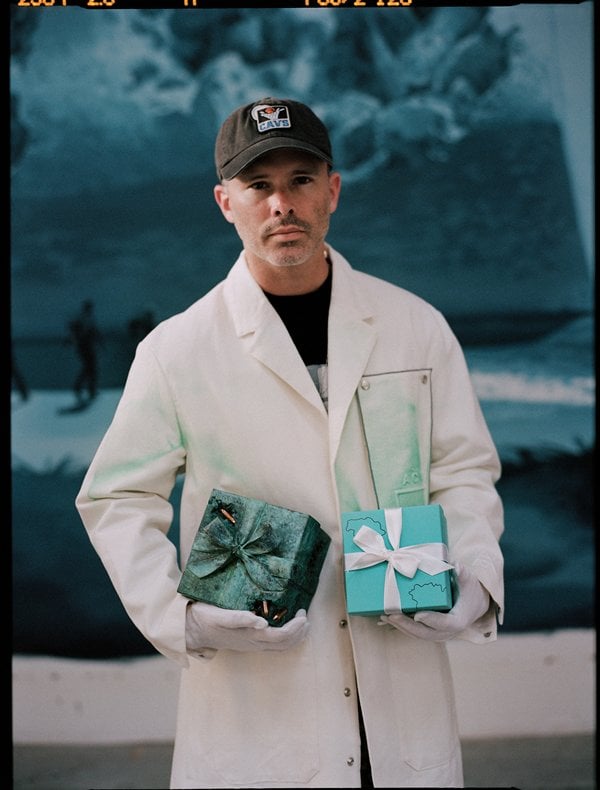
Less than a year into his new role as Tiffany’s executive vice president of product and communications, the 29-year-old LVMH scion Alexandre Arnault is already shaking things up in more ways than one.
In the last few months, the 184-year-old American jewelry house has undergone the start of what looks to be an exciting rebrand: rolling out campaigns featuring cross-armed models sporting chunky cuffs from Elsa Perretti’s collection beside bold signage that reads “Not Your Mother’s Tiffany,” securing Beyoncé and Jay-Z as brand ambassadors—and, most recently, debuting a limited-edition bracelet and sculpture for the company’s new Knot collection, conceived by none other than artist Daniel Arsham.
Beyoncé and Jay-Z with Jean-Michel Basquiat’s Equals pi (1982) for the Tiffany & Co. fall 2021 “About Love” campaign. Photo by Mason Poole.
The lattermost news is especially interesting. Tiffany has a long history of collaborating with artists—including Andy Warhol, who created playful Christmas cards for the brand for several years, beginning in 1956, and Robert Rauschenberg, who around the same time teamed up with fellow artist Jasper Johns to adorn the company’s Fifth Avenue flagship windows with enchanting displays—but this is perhaps the first time that Tiffany has given an artist the reigns to design arguably the starriest piece of a new collection.
Not only that, but Arsham was also asked to reinterpret Tiffany’s most recognizable piece of iconography: the Tiffany Blue Box.
An 1878 edition of the Tiffany Blue Box. Photo courtesy Tiffany & Co.
The box was originally conceived in 1852 and features that unmistakable robin’s-egg blue, selected as the company’s signature hue because of turquoise jewelry’s popularity in the 19th century. The stone became all the rage following the wedding of Queen Victoria, who gifted her bridal attendants dove-shaped brooches cut from turquoise as mementos.
When Tiffany began to assume popularity itself, the boxes became so popular that the brand had to advertise to the public that they were not, in fact, available for sale on their own, and could only be acquired with an actual purchase. In 1906, a reporter for the New York Sun wrote a cheeky column on the box craze—customers were reportedly walking into Tiffany’s flagship asking for boxes alone, presumably to use to gift other jewelry and objets d’art—and remarked, “Tiffany has one thing in stock that you cannot not buy of him for as much money as you may offer; he will only give it to you. And that is one of his boxes.”
Daniel Arsham’s Bronze Eroded Tiffany Blue Box sculpture beside the classic Tiffany Blue Box. Photo courtesy Tiffany & Co.
Taking this cultural history into account, Arsham conceived the Bronze Eroded Tiffany Blue Box, a 49-piece sculpture which houses a special-edition white gold bracelet whose knot is covered entirely in diamonds and tsavorite, a green gemstone from Kenya that Tiffany first introduced to the world in 1974.
The box will additionally become part of Arsham’s “Future Relics” series, in which the artist re-contextualizes contemporary objects and signifiers of the present culture through the lens of an imagined future in which they are excavated and preserved as artifacts of the past.
The diamond-and-tsavorite Knot bracelet. Photo courtesy Tiffany & Co.
Arsham’s box’s color—sporting patina over the eroded bronze material and the look of wear and tear over many years—has admittedly changed a bit, edging a little closer to Arsham Studio’s signature hue (in one interview, he dubbed it “Tiffany Green”), while also recalling archival images of Tiffany’s earliest boxes which, after years of aging, do appear slightly more green. In many ways, the shift reflects Arsham’s desire to link the brand’s present and future to its past.
Arsham’s supersize Bronze Eroded Tiffany Blue Box at the Tiffany flagship shop in New York. Photo courtesy Tiffany & Co.
“I always gravitate towards items that are immediately culturally recognizable,” Arsham said in a statement. “The Tiffany Blue Box has that power. I wanted to address it in a way different than how it was originally intended by giving it a distressed, aged quality which represents its history, how much of a fixture it is in our world today, and how it will continue to be relevant in decades, even centuries, from now.”
Additionally, at the Tiffany flagship on Fifth Avenue, an interactive, supersize version of the sculpture has been installed and is available for visitors to enter and experience.